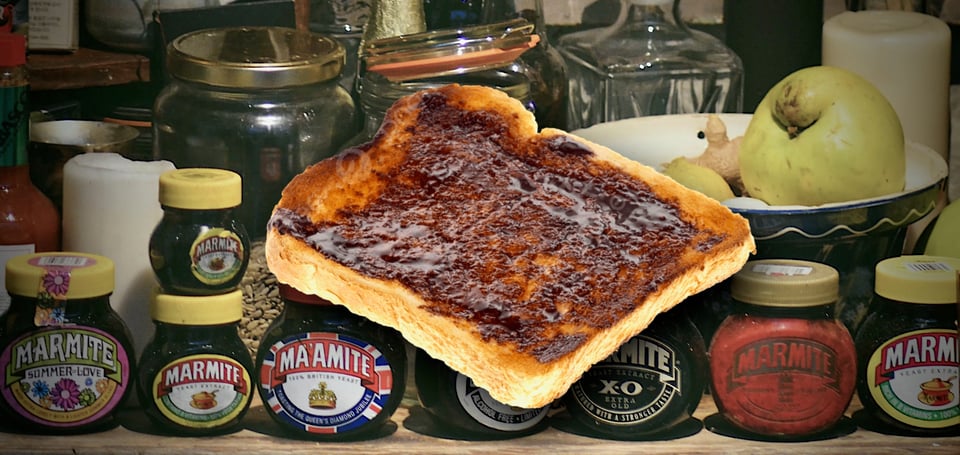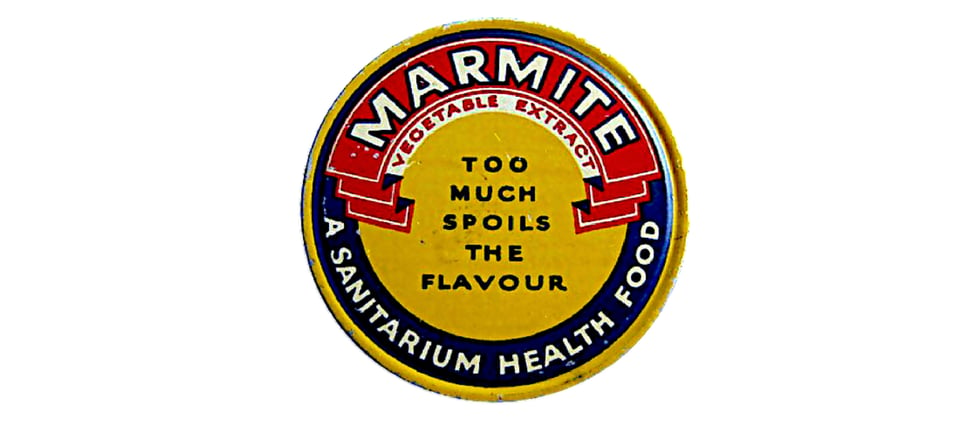Notable Sandwiches #113: Marmite

Welcome back to Notable Sandwiches, the feature where David and I travel the world on wings made of bread, chronicling Wikipedia’s List of Notable Sandwiches, in alphabetical order. This week, a British treat: Marmite.
(Note: This one’s gonna be short and sweet—unlike Marmite, which is very salty—because MY BOOK COMES OUT IN FOUR DAYS and I have STUFF TO DO ABOUT IT, such as vibrate with anxiety and go on podcasts. You can preorder it here!)

One of my favorite TV shows of all time is Taskmaster, in which a panel of British comedians is coerced into doing various silly tasks. In Series 5, one memorable challenge was “Make Marmite.” As the contestants pondered how to create various brown sludges, Yorkshire comedian Bob Mortimer pondered the best tactics for reproduce this infamous British spread. "Maybe put a cow in a room until it withers, and then you can mop up the residue," he suggested. (Later he explained that Marmite tastes like “salt, and the memories of meat.” He won the task.)
Bob was right in that Marmite tastes disconcertingly beefy, although it contains no beef. In fact, it contains no meat of any kind. The quick and dirty history of the spread is as follows: in 1902, the Marmite Food Company was founded in a disused malthouse in Burton-on-Trent, England, near the Bass Brewery. Nineteenth-century German chemist Justus von Liebig, a pioneer in fertilizer, mirror-making, and the eponymous Liebig’s Extract of Meat Company, had discovered that brewer’s yeast could be condensed down to form a dense, tarry, disconcertingly meconium-like extract.
Long a byproduct of the beer industry, brewer’s yeast is also, as was discovered a decade after the Marmite Food Company was founded, extremely rich in vitamins. It’s a kind of nutrient superpaste full of B vitamins like niacin, folic acid, and riboflavin. (It’s worth noting that the guy who coined the term “vitamin” in 1912 was the excellently named Polish chemist Casimir Funk, which sounds like a band with some extremely solid jams about pierogi.)
The Sword and the Sandwich is a newsletter about deadly serious extremism and serious sandwiches. Please consider supporting this work with
a paid subscription.
At any rate, its nutritive properties having been discovered just in time for Britain to go to war, Marmite began its journey to imperial ubiquity as a crucial part of British soldiers’ rations. Given that these poor men were suffering from trench foot, trench mouth, trench fever, plus stuff like typhus and scabies, giving them tons of Marmite seems unnecessarily cruel. But privation is ever the mother of nostalgia: from the Western front to the home front, Marmite soon became a staple at British tables. As to its name, there is no connection to our last sandwich—marmalade—other than extreme Britishness. The name probably derives from a pot-bellied French cookpot, which lent its distinctive shape to the company’s signature earthenware, then glass, jars.
Reader, I am not unwilling to suffer for my art, and so—despite being warned off by people who compared it to stuff like Icelandic hakarl (fermented shark) and Swedish surströmming (fermented herring illegal to take on planes), natto (snot-consistency fermented soybeans) and goat blood (blood from a goat)—I obtained myself a jar. It was dark, but not overtly threatening. I tasted a minute quantity on my tongue: very savory, umami.

But reader, we are here to discuss sandwiches, not just spreads in and of themselves. The overwhelming recommendation was to put a minute amount of Marmite on buttered bread. Or “lashings of it on a crumpet,” as one Bluesky user recommended to me, which sounds very British indeed (I keep reading Gothic romances set in Cornwall and the Yorkshire moors and I haven’t been to the UK since I was 12, so I sometimes have difficulty believing Britain is real, such as when people recommend I put lashings of Marmite on a crumpet. I’m not gonna bake a crumpet on a random weeknight! I’m not Nigella Lawson!)
I spread it thinly on some buttered butter naan (I only had naan in the house, for some reason). Because naan has some bubbles and crevices and also isn’t particularly porous, there were some unexpected pockets of Marmite buildup. The effect—despite some initially pleasant bites, because a whole bunch of butter helps the niacin go down—was overwhelming.
It was as if I had drunk meat-flavored seawater.
I didn’t find it overtly repulsive (as I did hakarl; that shit was nasty and tellingly came with an 80-proof brennivin shot as a chaser), but I am glad I exercised caution, because blithely downing a teaspoonful would have been a recipe for instant and overpowering regret. As it was, my heartbeat was significantly elevated for like twenty minutes after consuming a spread that is 14% salt and 86% ersatz-yet-haunting beefiness.

I’ve since been told that a) I messed up by not putting it on some sliced plain toast (or a “Scottish loaf” whatever that is) and b) that however thinly I thought I spread it, I should have spread it MORE THINLY, and c) that I might like it more as a sort of vegan bouillon substitute in soups and stews. I believe all of these things, but for now this petite jar is glowering at me from my fridge [Ed. Note: You definitely do not need to refrigerate Marmite, Talia], daring me to delve into its salty depths and be lost like a sailor in a gale. I have thus far managed to resist, despite the usual oppressive cupio dissolvi that grips me in autumn.
It’s possible that the vital niacin, protein, riboflavin, et al, contained in Marmite helped sustain gentleman officers such as Siegfried Sassoon, Wilfred Owen, Robert Graves, Owen Jones, Percy Wyndham Lewis, and Edmund Blunden in their various prosaic and poetic efforts to document the horrors of war. For this I must commend it: via the roundabout route of reading a lot of these books, I must have vicariously consumed a lot of Marmite. My appetite for memoirs of the Great War is endless; my appetite for Marmite is significantly less so. Both are, however, dark and bitter, very British, and, in their own ways, changed the world.

-
My UK born husband would annually urge Marmite upon me. It's a BIG NO. The small jars began clustering, until I tossed them all.
-
The other running joke about the origin of Marmite is that it's honey made by wasps.
-
My partner has gotten used to the smell of it after 25 years together, but they used to leave the room when I had Marmite on toast.
I always caution people to spread the thinnest possible amount to start with, so that it barely colors the butter as you spread it around. But at this point, I've eaten it all my life and I love it, so when I spread it on toast, it is thick enough to be almost black all over.
It's very versatile and definitely can add umami to cooking. I used to have cucumber and Marmite sandwiches a lot as a kid. I also like it in a cheese sandwich, rather than pickle (British pickle, which is closer to a thick, chunky, brown relish).
Sometimes for Marmite on toast, I'll spread cream cheese instead of butter, and then slather lashings of Marmite on top of the cream cheese.
-
Peanut butter and marmite are an excellent combination. Definitely need to go easy on the Marmite if you are a neophyte, though.
Plain white toast is usually the preferred conveyance, though things like challah or Japanese milk bread are also pretty good.
The “Scottish loaf” referred to might be this, as contrasted with the more posh “pan loaf” https://en.m.wikipedia.org/wiki/Plain_loaf
-
Marmite is basically Bovril for lightweights…
-
I think you might have misread the nutrition facts. It's "only" 10% salt by weight. One serving (8g) contains 14% of the daily recommended salt intake.
-
Hehehehehe.
NZ stuff's a bit less saltier it seems, because I got for maximum thickness when making sandwiches or folding a slice of toast with marmite on it over a slab of cheese.
I also have an utterly horrifying marmite, cheese, onion and chilli "white"sauce pasta dish that's my mad adaption of Nigella Lawson saying butter and marmite make for a nice sauce for pasta. It does, but it needed "something more".
Looks terrible, utterly delicious and microwaving the left overs, for some obscure reason, turns it into pure heroin.
-
My kids love it. Best way to control the dosage in my opinion is to premix it with softened unsalted butter. Proportions to taste but I guess a sort of cafe au lait colour. It grows on you.
-
When I lived in rural England for my 6th year, I distinctly remember taking a marmite sandwich at a birthday party, thinking from the colour it must be peanut butter, and having a terrible terrible shock. The vagaries of verbal comprehension and memory at that age, plus the incredibly plain diet of my Canadian upbringing, led me to confusing marmite and mayonnaise, and so I studiously avoided mayonnaise up until leaving home and being convinced to try it by my wife and being shocked it is in fact good.
A few times later in life I've been convinced to give it a try again, and though I see the use as seasoning in savoury dishes, I have yet to spread a small enough amount on toast to discover enjoyment.
-
Brilliant essay. On Great War memoirs: if you've not read Helen Zenna Smith's Not So Quiet, you would probably find it excellent. It's written from the perspective of a British woman ambulance driver on the Western Front.
Add a comment: